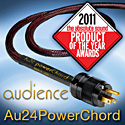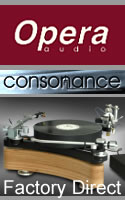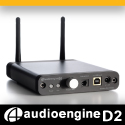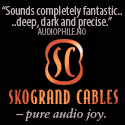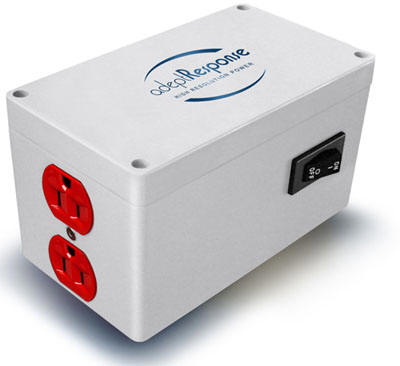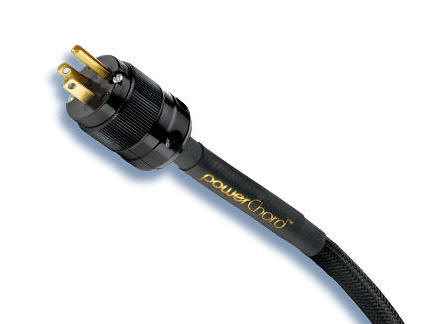|
|
You are reading the older HTML site
Positive Feedback ISSUE 59
audience aR2p-TO AC Conditioner as reviewed by John Acton
Audience company President John McDonald and team must not like to take vacations. Over the past couple of years, Audience has kept busy augmenting its extensive portfolio of cabling and power-conditioning solutions with a full line of high-end loudspeaker systems. As if that weren't enough, Audience has introduced enhanced ‘e' versions of several of its interconnect, speaker cable, and power cord products, as well as significant upgrade revisions to its stable of power conditioners. In 2008, I reviewed the Audience aR1p power conditioner and was bowled over by the gains in transparency and detail retrieval it brought to my system, and I was just as impressed with what it didn't do, namely compromising dynamics. Since that time, Audience has discontinued production of the single-outlet aR1p in favor of a larger two-outlet model, logically named the aR2p. Along the way, the aR2p was updated to include Audience's premium Auracap capacitors. Audience then augmented the standard aR2p model with the aR2p-T, which swapped out the Auracap capacitors in lieu of the company's top-of-the-line (and extremely costly) Aura-Teflon capacitors in the filter sections. And most recently, Audience has replaced the aR2p-T with the aR2p-TO, which now includes not only the fancy Aura-Teflon capacitors, but also OHNO (high-purity continuous copper) connecting leads. The aR2p-TO does not require a power cord, being designed to plug directly into the wall socket. The aR2p-TO measures 3.56” wide by 6.31” high by 3.56” deep and weighs 1.8 pounds. Externally, the aR2p-TO’s appearance is understated, and its feature set consists simply of two Hubbell high-conductivity power receptacles, a Marinco high-conductivity power plug and an on/off breaker power switch. Internally, however, the aR2p-TO's circuit is nearly identical to that of its larger and considerably more costly stablemates, the aR6 and aR12. Like its big brothers, the aR2p-TO is optimized for dynamic range via extremely low DC resistance, and Audience instills the conditioner with partial power factor correction by bringing the voltage and current into closer relation to one another for ensuring proper phase; the resulting benefit of this power factor correction is a claimed subjective increase in a system amplifier’s output power by 10%. Audience eschews circuit boards in the aR2p-TO, choosing instead to hand-wire all connections. The aR2p-TO utilizes powerChord wire for the internal power wiring and wire harness and employs non-resonant damping. Audience cryogenically treats the entire circuit. Ultimately, all of this translates into a full ability to isolate components from EMI and RFI, both inside and outside of the AC line. The aR2p-TO comes with a 15-amp on/off breaker switch and is able to deliver 1,800 watts of power on a continuous basis, with a capability to deliver at least 3,600 watts for an unspecified short period of time. Customers with greater power-delivery requirements can order the aR2p-TO with a 20-amp breaker, which increases power handling to 2,400 watts continuous. Last but not least, the Audience conditioner possesses over-voltage protection utilizing a non-wearing, non-MOV solution that can withstand a 20,000 amp discharge and is said to be sonically transparent. Like all Audience power conditioners, the aR2p-TO is warranted for a period of 10 years. So, with all those features and possessing a nearly identical circuit, why would anyone choose to spend more money for one of the larger Audience power conditioners? Well, aside from the obvious increased number of outlets, the aR6 and aR12 benefit from considerably more robust construction, including a ground plane of solid copper. Secondly, and most importantly, the larger models incorporate individual filtering for each outlet, which isolates each connected component from one another. In contrast, the aR2p-TO is constructed of a polycarbonate case with no copper ground plane. And the smallest Audience conditioner does not provide individual outlet filtering for complete component-to-component isolation. McDonald did inform me that the aR2p-TO outlets possess a very low impedance at high frequencies, which in and of itself imbues the conditioner with a high level of isolation between components. For those who demand the utmost in individual filtering, Audience can custom-build aR2p models with fully-isolated outlets. This requires a larger enclosure, with pricing determined on a case-by-case basis. Anyone interested is encouraged to contact Audience directly to discuss their individual requirements. Prospective purchasers should take note that the Audience aR2p-TO requires a significant period of time to break in on account of the Teflon capacitors employed in the filtering sections. Audience recommends 500 hours, and based on my experience, that number should be treated as an absolute minimum. To ameliorate the break-in experience, Audience does burn in every one of its power conditioners for 72 hours at the factory via a high-current device. McDonald thus clarified that the 500-hour user break-in is for passing voltage. What this means for us users is that rather than hooking up the conditioner to refrigerators, big-screen televisions or mainframe computers, we can simply plug it into an unused AC outlet, turn it on and forget about it for a month. During the review period, I auditioned the Audience aR2p-TO in the context of two systems. I spent a good deal of time listening via a headphone system comprising a SimAudio MOON CD5.3 CD player, STAX SR-007 electrostatic headphones, STAX 006tS headphone amplifier, a Kimber Kable Hero AG interconnect and Audience PowerChord and PowerChord e power cables. Later, I moved the aR2p-TO into a speaker-based system comprising the same SimAudio CD5.3 CD player, Kimber Hero AG interconnect and Audience PowerChords, but adding a Cayin A-55T integrated amplifier, Monitor Audio Gold GX50 loudspeakers, Kimber Kable 4TC speaker cables and Sanus Granite Foundation speaker stands. In all cases, a SolidSteel 6.2 Audio Table provided system support. As impressed as I was earlier with the aR1p, I had perhaps inordinately high expectations for the aR2p-TO. Within minutes, the aR2p-TO blew those expectations clean out of the water, and over the course of the next few months, my dependence on the little Audience power conditioner and the benefits it brought to my system, and more importantly, to my musical enjoyment, only deepened. I've always placed a great deal of importance on a system's ability to create a credible soundstage, and within that, dimensional and life-like images. With the Audience aR2p-TO in place, the soundstage expanded, not only in terms of width and depth, but also with respect to height. Listening to well-recorded electronic fare such as Javi Canovas' Nights of Brightness (MusicZeit 16 / 44.1 download; Synth Music Direct CD), the soundstage spread further laterally beyond the speaker locations and extended several feet further back in the depth plane. On "Fugitive Star," the Mellotron flute floated well above the speaker cabinets, and I heard a subjective amelioration of the digital ceiling, with less truncation of the air above and around instruments. Image density was also improved, with images within the soundstage more fleshed-out and dimensional, which made for a reach-out-and-touch-it realism. With the aR2p-TO conditioning my system's AC, I could scarcely credit the dimensional body Miles Davis' trumpet on Kind of Blue (Columbia/Legacy CK 64935) now possessed, and Ike Willis' vocal on "Lucinda Has Messed Up My Mind" from Frank Zappa's Joe's Garage (RYKODISC RCD 10530) was in-the-room palpable. Once I became accustomed to the spatial improvements wrought by the Audience aR2p-TO, I was able to turn my attention to how much additional clarity, detail and sheer information was being communicated via my headphones and speakers. The resolution that my system was able to wring out of long-familiar recordings was, at times, staggering. Bill Bruford and Pat Mastelotto's multi-tracked dual-drum solo "B'Boom" from King Crimson's Thrak CD (Virgin 24381 21802) has a lot going on, and subsequent to installing the Audience conditioner, I was able to much more easily follow the complex interplay between Mastelotto and Bruford contrasted against the backdrop of Robert Fripp's atmospheric synthesizer playing. The aR2p-TO introduced no changes in tonality, but there was a newfound vibrancy and precision associated with the overall presentation. In the midrange, voices and instruments were imbued with a greater sense of body and immediacy, as was readily apparent listening to Roger Waters and Paul Carrack trading lead vocals on "The Powers That Be" from Waters' Radio K.A.O.S CD (Columbia CK 40795). And while bass instrumentation was not reproduced with artificially-hyped power or extension, there were improvements in tautness and control, which manifested itself via less bloat and overhang, more clarity and nuance. I was frankly not prepared for the improvements I heard in the treble as a result of the aR2p-TO. I discerned greater transparency and less grunge and grit. Cymbals and high hats were reproduced with much greater realism, even on sub-optimally recorded or mastered CDs like Clinic's Winchester Cathedral (Domino DN035CD) or UK's Danger Money (E'G Records EGCD 39). Perhaps the most illuminating evidence of the Audience aR2p-TO's capabilities is to remove it from one's system after having grown accustomed to its effects. Without the aR2p-TO in place, I immediately heard a compression and flattening of the soundstage, a subtle patina of grit overlaying the presentation and an overall lack of vibrancy and verisimilitude that had me quickly scrambling to re-insert the little conditioner back into the system. While less pricy than other state-of-the-art power conditioners, including Audience's own flagship offerings, the aR2p-TO is certainly not inexpensive at $1600. My own experiences with power conditioners in the past have never swayed my opinion that while AC conditioning is a nice-to-have, there are better ways to spend my money when it comes to system upgrades. Well, all that has changed with the aR2p-TO. Even within the context of my relatively modest system, the smallest Teflon-capped Audience conditioner has elevated itself from accessory to essential, enhancing the sound and my overall musical enjoyment as much or more than any other component upgrade I've made. I'm putting my money where my mouth is and purchasing the review sample.
Postscript: Audience's powerChord AC power cords have been a mainstay in my system for years. Extremely flexible, the low-resistance, low-impedance powerChord allows music to emerge from a quieter background, which results in heightened transparency and greater dynamism. In my experience, the Audience powerChord excels at knitting the soundstage together spatially and in optimizing a system's temporal coherence, areas in which it has bested every other power cord I've auditioned, including some priced considerably higher. When McDonald learned of my preference and respect for the regularly-aspirated powerChords, he suggested (practically insisted) that I try a pair of the enhanced 'e' version powerChords. From a construction standpoint, the Audience powerChord 'e' represents a complete re-build and re-termination of the standard powerChord. The best part is that current owners can have their powerChords upgraded by Audience to 'e' status simply by sending them back to the factory, where, for a charge of $165 per cable, Audience performs the upgrade, re-terminates the cables and returns them to their owners. Note that, as a result of the re-termination process, the returned cords will be a few inches shorter. In directly comparing the enhanced Audience powerChord 'e' to the non-enhanced version, I discerned a significant improvement in the overall sound of my system with the powerChord 'e' installed. There was a clearly audible reduction in the noise floor, with a concomitant increase in detail retrieval. There was more air around instruments, and the reproduction of dynamic contrasts was improved over the already class-leading performance of the non-'e' powerChord. Bass was tighter, with more texture evident, the midrange was presented with greater articulation and immediacy, and the treble registers were likewise reproduced with greater extension and air, with a reduction in grunge and grit. If such a thing is possible, the enhanced Audience powerChord 'e' represents an even greater bargain than the standard powerChord, and at its retail price of $695 may be the best power cord available for anywhere near its price. For existing powerChord owners, the low $165 cost of upgrading makes the enhanced 'e' version perhaps the greatest bargain in all of high-end audio. John Acton
aR2p-TO power conditioner
powerChord AC power cord
Audience AV
|
